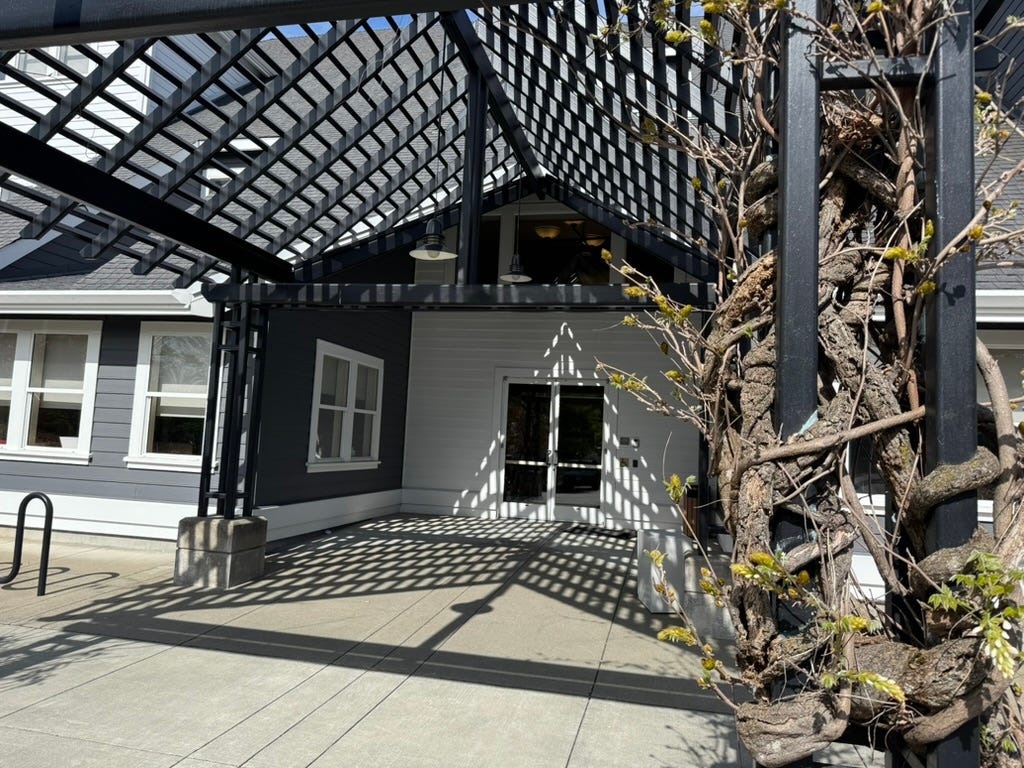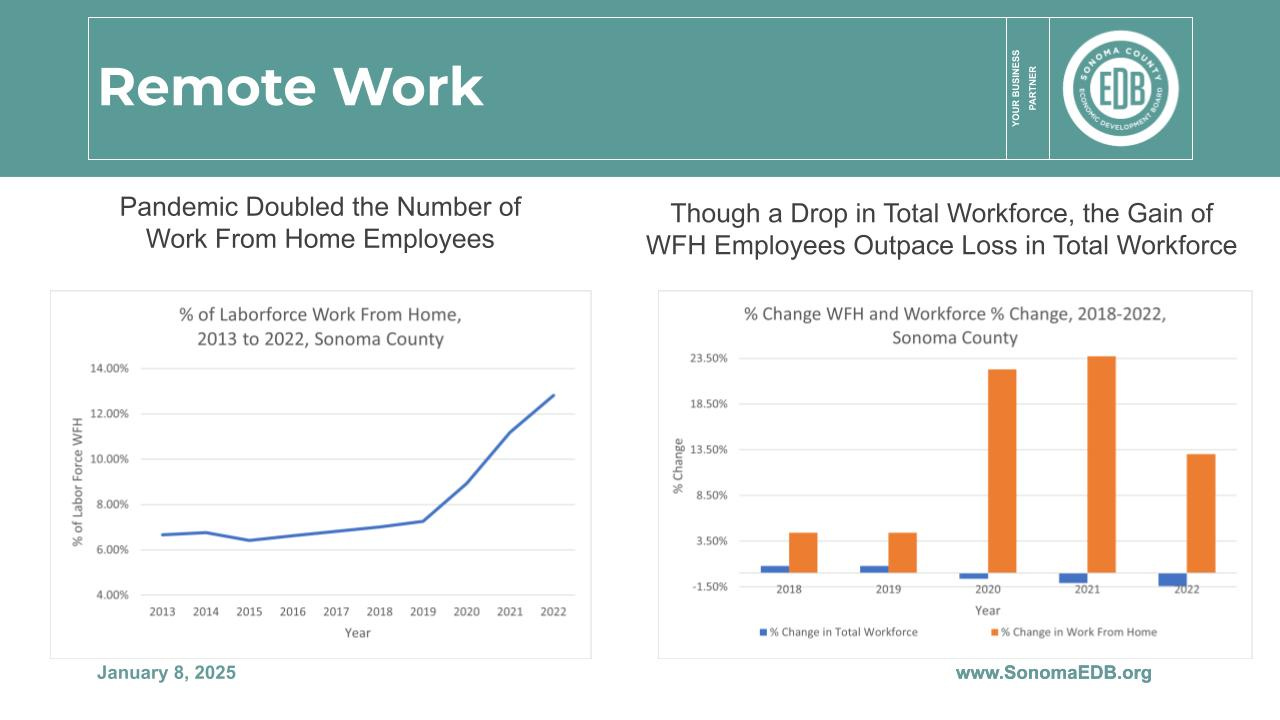WFH West County: Work from where you want to live
A five-part series looks at Work From Home (WFH) as a local trend and profiles those who have jobs they can do remotely from their home office
Seeing the O’Reilly building emptied out over the last few weeks brought back memories for me. Hundreds of people once worked there in two main buildings with three floors of office space, plus a warehouse. It represented a dream of having an O’Reilly campus that was used daily by those who worked there but also welcomed others for tech events and community events.
When Covid hit, those who worked at O’Reilly began working from home, like many others. In the case of O’Reilly employees, they never came back to the office in Sebastopol or Boston.
I was one of those people who went to the O’Reilly office every day for a dozen years or more, but now at Make, which had spun off from O’Reilly, I work from home as do the people who work with me from different parts of the Bay Area and others who live across several time zones.
This is the first part of a five-part series that looks at the shift to remote work in Sebastopol and West County, what might be considered a hidden-away-at-home workforce. WFH is changing where and how people work today, offering a good living in a good place to live and work. Varies data sources suggest that overall WFH is a growing trend in Sonoma County that is re-shaping the local economy.
Growth of the WFH workforce
A 2023 Pew Research Center national survey found that one third (35%) of workers with jobs that can be done remotely are choosing to work from home all of the time. “The majority of US workers (61%) do not have jobs that can be done from home,” according to the study.
The effects of Covid on the workforce are still felt today. Only 7% of the workforce worked remotely before the pandemic but it shot up to 55% in October 2020, months after the peak of Covid. By January 2022, the percentage was down to 43%, falling to 35% of workers in 2023, according to the Pew survey. (Some national research suggests that a quarter of the workforce works from home but the studies and surveys are rather inconsistent.)
On a list of counties in California with the highest number of people working from home, Sonoma County ranks 16th, with 20.6% of its total adult workforce of 232,502 working remotely. That’s about 46,000 people working from home in the county.
Jack Kampmann, Economic Research & Workforce Initiatives Fellow at the Sonoma County Economic Development Collaborative, said that 25.1% of the workforce living in the West County reported working from home, compared to 12.1% in Sebastopol, as of 2023. “These figures suggest a consistently higher rate of remote work among Sonoma Coast residents compared to those in Sebastopol,” wrote Kampmann in an email.
“Moreover, the rate of those working from their primary residence has continued to increase year over year since the beginning of the pandemic. In Sonoma County, the percentage of remote workers in the total workforce doubled because of the pandemic,” Kampmann wrote. “Essentially, companies shifted the liability and overhead of office space to their subsequent workforce.”
In the chart on the left, the number of WFH employees is at 13% in 2022. Kampmann said that the number grew to 14.4% in 2023. In the above chart on the right, Kampmann explained that the “rate of change, year over year, for total WFH employees outpaces the rate of change for workforce change, including the declines from 2020-2022.” WFH home employees are a growing part of the economy, even as the total size of the workforce in Sonoma County has declined since Covid.
Kampmann said that WFH has an impact on other parts of the local economy. The above charts are from a presentation that Kampmann gave in January at Redwood Empire Remodeler's Association. “While the US economy shrank by 3.5% in 2020, spending on home improvements and repairs grew more than 3%, to nearly $420 billion, as households modified living spaces for work, school, and leisure in response to the COVID-19 pandemic. As work from home becomes increasingly synonymous in a variety of industries, home improvement projects have become ever popular in areas like Sonoma County.”
Sonoma County’s “Secret Export”
In his presentation “Clever Economy,” local author Steven Thomas says that “remote workers are Sonoma County’s secret export/import economy…remote workers export their work over the internet and import paychecks from companies outside the area.” Sonoma County’s Bay Area location is “too far north to be commutable, but close enough to be economically tied to this wealthy metropolis of 12 million people. This close connection translates into businesses expanding north, telecommuters, second home buyers, and people retiring to Sonoma.” It’s a trade of services performed at home for a business that might no longer has a physical office anywhere, serving customers and clients who might be anywhere in the world.
What Jobs are WFH Jobs
Not all jobs can be done from home, but many service sector jobs can be done remotely. The tech industry has a lot of those kinds of jobs that are done by remote teams. That trend is reflected in the people interviewed in this article. Those who can work from home generally have a high level of education, and they have already established themselves in a career.
According to Work From Home Research, the categories of those working from home in the US in March 2024 were split as follows:
Professional and business services: 29%
Finance and insurance: 23%
Information sectors: 21%
Those who search for WFH jobs might find some companies don’t allow it while others do. However, the job search need not be limited to the local job market.
If West County was once considered a bedroom community where people commuted elsewhere for work, it’s become an office-in-a-spare-bedroom community, as you’ll see in this special series.
WFH Profiles
You will meet eight individuals who work from home in West County, which includes two couples who both work from home:
Cato Grace, a technical marketer;
Jeffrey Kross, an attorney specializing in criminal appeals;
Neil Parkin, a molecular biologist and virologist;
Sara & Chris Osborn, a product manager and an engineering manager, respectively;
Kat Deaner, a conservation planner;
Michael Greenberg, an optical engineer, and Lori O’Hara, a Medicare audit manager for skilled nursing facilities.
They live in Sebastopol, Graton, Forestville and Occidental.
Like a nosy neighbor, I asked them about their business. I wanted to learn how long they had been working from home and if they prefer it to working in an office. I wanted to learn what they saw as the benefits of working from home as well as some of the challenges. I interviewed everyone online using Zoom Google Meet. In other words, I met each of them where they work at home.
One thing that surprised me was that few of the eight people who work from home know anyone else in this area who worked from home.
WFH Profile: “Not all companies are remote friendly”
Cato Grace - Technical Marketer
The subject of the first WFH profile is Cato Grace, who worked from home before Covid, but after Covid, the company he worked for changed its work-from-home policy and he found himself looking for another job that he could do remotely.
Cato Grace is a technical marketer working for software companies from his home in Sebastopol. His job is to explain in detail how the software works and meets the needs of a corporate buyer. He creates presentations and video demos and blogs and stuff. He and his wife moved to Sebastopol in 2016, and he began working remotely. “When COVID happened, nothing really changed about my work,” said Grace.
“The whole time that I've lived in Sebastopol, I’ve worked remotely for one of two companies,” he said. “When I moved here, I was working for VMware and then in the middle of last year I got laid off. I was out of work for about six months and then I just recently got hired by HP. I've been working there for a few months.”
“When I was hired by VMware, I lived in New Mexico, and it was my manager's manager who wanted me to be in the office and so they actually moved me from New Mexico to Cupertino. They paid for the move. Then about a year after I moved, my manager's manager changed and that new person didn't care where I lived.” So he left Cupertino for Sebastopol.
“The rest of my team was all remote, so I was the only one who was in the office. For a time it was helpful because some of the engineers who I worked with were there as well, but eventually all of the development for the product that I worked on moved to Bulgaria.”
VMware was friendly to employees who wanted to work remotely. But then the company was acquired by Broadcom and Broadcom wanted all of its employees in the office. “I wasn't laid off for a performance reason,” he said, at least he wasn’t told he was laid off because he worked remotely. However, others who were laid off also worked remotely.
Searching for a new job was made harder because he and his family didn’t want to move. “My job search was fairly challenging. My wife and I had discussed at least the possibility of working at a place that would require me to be on site.” He applied for some jobs that were not remote, but the majority of the jobs he looked at were remote but there were fewer of them. “Companies who in the past have been remote friendly – Amazon is one that I can think of off the top of my head – now require employees in the office.”
While working remotely, he didn’t always work from home. He rented space in the Barlow on Morris Street. “A few years ago, especially in the summer, it was really challenging having my kids be at home and trying to work.” He got to know some of the other people who had spaces there. “Having a shared break room where you'd run into people and have hallway conversations and stuff like that,” were things he enjoyed. He looked at co-working spaces, but they weren’t a good fit for him.
Now, Cato works in a converted attic space at home. His kids are 17 and 13. “I've had a standing desk for a very long time, but I just recently added a treadmill under my standing desk. So, it makes the experience of being in meetings a whole lot better.”
I asked Grace if he knew other people who worked remotely and he said he didn’t. “I'm a volunteer firefighter (in Sebastopol) and so I talk to everybody else at the volunteer fire department and nobody else does remote work. Telling them that I do remote work is kind of strange to them.”
His work as a volunteer firefighter for Sebastopol has really helped him feel connected to the community. He’s not particularly happy about the consolidation of the Fire Department with Gold Ridge “I see the benefit of the change happening but I feel disappointed as well.”
From New Mexico to Cupertino to Sebastopol, Cato said “being a remote worker doesn’t seem particularly interesting to me,” by which he meant that it's just what he does for work. It seems utterly normal to him.
The second part of the series will be published next Monday, May 5th.







Hello Dale
Maybe the O Reilly building is the place we are looking for to house our preschool, Senior and teen centers!?
My sons in Wisconsin work from home. I'll share this story with them. You mentioned work from home people don't know each other. Maybe this series will prompt them to get together socially to chat about at home life. Great reporting, by the way!